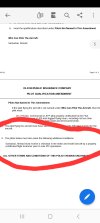midlifeflyer
Touchdown! Greaser!
May depend. I've looked at the policies of most of the clubs and flight schools I've dealt with through the years. All of them had a single policy that covered all the aircraft - both owned and leasebackd - for both liability and hull damage.Still, that’s 3 different owners, 3 different insurance policies, and each likely requires a checkout. Simplest policy is just to require a checkout in everything.
I some cases, an leaseback lessor, not satisfied with the coverage of the organization policy have had their own, but that was typically supplemental to the lessee's policy.


